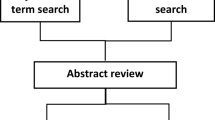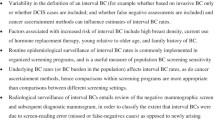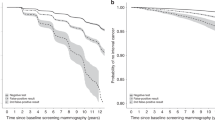Abstract
Background
The literature shows that breast screening performance varies between centers. Those who monitor the performance of screening programs must use appropriate methods to demonstrate quality. Analysis of interval cancer rates provides one such measure. This study analyses interval cancers over a ten-year period in a single center of the UK National Breast Screening Program, offering screening to a population of 45 000 women.
Methods
108 948 screening examinations were undertaken between 1987 and 1996. Sequential interval cancer rates were studied and compared with the results of the Swedish Two-County trial. More detailed analysis of the first prevalence round was undertaken.
Results
Improvement in rates occurred after three years. Two-year time bands show some fluctuation in rates, indicating variation in performance. For one time period, rates equivalent to the Two County Trial were achieved, but this was not consistently maintained. Overall rates equate to performance reported elsewhere in the UK (25% in the first year after screening, 48% in the second year after screening and 48% in the third year after screening, equivalent Two County rates are 17%, 32% and 57%). The prevalence round analysis shows that undiagnosed cancers arose after the film reading stage in 88% of interval cases. The team was able to distinguish minor signs from significant lesions effectively. Assessment procedures were effective once the patient had been recalled.
Conclusion
Interval cancer rates fell initially but reached a plateau. Recall procedures were effective in making the diagnosis, and cases were missed at the film reading stage. Consistency of performance may be important in achieving low rates.
Similar content being viewed by others
Abbreviations
- UK NHSBSP:
-
UK National Health Service Breast Screening Program
- UKCCCR:
-
United Kingdom Co-orginating Committee for Cancer Research
References
Day N, Williams D, Khaw K: Breast cancer screening programmes; The development of a monitoring and evaluation system.Br J Cancer 59:954–958, 1989.
Asbury D, Boggis CR, Sheals D,et al: NHS breast screening programme; Is the high incidence of interval cancers inevitable?BMJ 313:1369–1370, 1996.
Day N, McCann J, Camilleri-Ferrante C,et al: Monitoring interval cancers in breast screening programmes; The East Anglian experience.J Med Screening 2:180–185, 1995.
Moss S, Coleman D, Ellman R,et al: Interval cancers and sensitivity in the screening centres of the UK Trial of Early Detection of Breast Cancer.Eur J Cancer 29:255–258, 1993.
Kee F, Gorman D, Odling-Smith W: Confidence intervals and interval cancers; Needles and haystacks.Public Health 106:29–35, 1992.
Brekelmans C, Colette H, Colette C,et al: Breast cancer after a negative screen; Follow-up of women participating in the DOM screening programme.Eur J Cancer 28:893–895, 1992.
Peeters P, Verbeek A, Hendriks J,et al: The occurrence of interval cancers in the Nijmegen screening programme.Br J Cancer 59:929–932, 1989.
Faux A, Richardson D, Lawrence G,et al: Interval breast cancers in the NHS breast screening programme; Does the current definition exclude too many?J Med Screening 4:169–173, 1997.
Woodman C, Threlfall A, Boggis C,et al: Is the three year breast screening interval too long?; Occurrence of interval cancers in NHS breast screening programme’s north western region.BMJ 310:224–226, 1995.
Duncan A, Wallis M: Classifying interval cancers.Clin Radiol 50:774–777, 1995.
Simpson W, Neilson F, Young J,et al: The identification of false negatives in a population of interval cancers; A method for audit of screening mammography.The Breast 4:183–188, 1995.
Field S, Michell M, Wallis M,et al: What should be done about interval breast cancers?BMJ 310:203–204, 1995.
Burhenne H, Burhenne L, Goldberg F,et al: Interval cancers in the screening programme of British Columbia; Analysis & classification.AJR 162:1067–1071, 1994.
Moskowitz M: Interval cancers and screening for breast cancer in British Columbia.AJR 162:1072–1075, 1994.
Moseson D, Meharg K: Tumor registry audit of mammography in community practice.Am J Surg 167:505–508, 1993.
Reintgen D, Berman C, Cox C,et al: The anatomy of missed breast cancers.Surg Oncol 2:65–75, 1993.
van Dijk J, Verbeek A, Hendriks J,et al: The current detectability of breast cancer in a mammographic screening programme; A review of the previous mammograms of interval and screen detected cancers.Cancer 72:1933–1938, 1993.
Bird R, Wallace T, Yankaskas B: Analysis of cancers missed at screening mammography.Radiology 184:613–617, 1992.
Andersson I: What can we learn from interval cancers?Recent Results of Cancer Research 90:161–163, 1984.
Martin J, Moskowitz M, Milbrath J: Breast cancer missed by mammography.AJR 132:737–739, 1979.
Vitak B: Invasive interval cancers in the Ostergotland mammographic screening programme; Radiological analysis.Eur Radiol 8:639–646, 1998.
Burrell H, Sibbering D, Wilson A,et al: Screening interval breast cancers; Mammographic features and prognostic factors.Radiology 199:811–817, 1996.
Johnson A, Shekhdar J: Interval cancers in the National Health Service Breast Screening Programme.Br J Radiol 68:862–869, 1995.
Brekelmans C, Peeters P, Deurenberg J,et al: Survival in interval breast cancer in the DOM screening programme.Eur J Cancer 31:1830–1835, 1995.
Ciatto S, Roselli del Turco M, Bonardi R,et al: Mammographic screening; An analysis of the characteristics of interval carcinomas observed in the programme in the province of Firenze (1989-91) [Italian].Radiologia Medica 87:412–416, 1994.
Brekelmans C, Peeters P, Faber J,et al: The epidemiological profile of women with an interval cancer in the DOM programme.Breast Cancer Res Treat 30:223–232, 1994.
Hollingsworth A, Taylor L, Rhodes D: Establishing a histologic basis for false negative mammograms.Am J Surg 166:643–647, 1993.
Senie R, Lesser M, Kinne D,et al: Method of tumor detection influences disease-free survival of women with breast carcinoma.Cancer 73:1666–1672, 1993.
Klemi P, Joensuu H, Toikkanen S,et al: Aggressiveness of breast cancers found with and without screening.BMJ 304:467–469, 1992.
Frisell J, von Rosen A, Wiege M,et al: Interval cancer and survival in a randomised breast cancer screening trial in Stockholm.Breast Cancer Res Treat 24:11–16, 1992.
von Rosen A, Frisell J, Nilsson R,et al: Histopathological and cytochemical characteristics of interval breast carcinomas from the Stockholm mammography screening project.Acta Oncol 31:399–402, 1992.
Ikeda D, Andersson I, Watsgard C,et al: Interval cancers in the Malmo mammographic screening trial; Radiographic appearance and prognostic considerations.AJR 159:287–294, 1992.
Yoshida K, Abe R, Itoh S,et al: Comparison of interval breast cancers with other breast cancers detected through mass screening and in outpatient clinics in Japan.Jpn J Clin Oncol 20:374–379, 1990.
Holmberg L, Tabar L, Adami H,et al: Survival in breast cancer diagnosed between screening examinations.Lancet ii:27–28, 1986.
von Rosen A, Erhardt K, Hellstrom L,et al: Assessment of malignancy potential in so-called interval mammary carcinomas.Breast Cancer Res Treat 6:221–227, 1985.
deGroote R Jr, Milazzo J, Warden M,et al: Interval breast cancer; A more aggressive subset of breast neoplasias.Surgery 94:543–547, 1983.
Holland R, Mravunac M, Hendriks J,et al: So-called interval cancers of the breast.Cancer 49:2527–2533, 1982.
Tabar L, Fagerberg G, Chen H,et al: Screening for breast cancer in women aged under 50; Mode of detection, incidence, fatality and histology.J Med Screening 2:94–98, 1995.
Vitak B, Olsen K, Manson J,et al: Tumour characteristics and survival in patients with invasive interval breast cancer classified according to mammographic findings at the latest screening; A comparison of true interval and missed interval cancers.Eur Radiol 9:460–469, 1999.
Wotverton D, Sickles E: Clinical outcome of doubtful mammographic findings.AJR 167:1041–1045, 1996.
Brenner R: Medicolegal aspects of breast imaging.Radiol Clin North Am 30:277–286, 1992.
Brenner RJ: Mammography and malpractice litigation; Current status, lessons, and admonitions.AJR 161:931–935, 1993.
Maes R, Dronkers D, Hendriks J,et al: Do non-specific minimal signs in a biennial mammographic breast cancer screening programme need further diagnostic assessment?Br J Radiol 70:34–38, 1997.
Forrest A: Breast Cancer Screening, HMSO, London, 1986.
Brown J, Bryan S, Warren R: Mammography screening; An incremental cost effectiveness analysis of double versus single reading of mammograms.BMJ 312:809–812, 1996.
Bryan S, Brown J, Warren R: Mammography screening; An incremental cost effectiveness analysis of two versus one view procedures in London.J Epidemiol Community Health 49:70–78, 1995.
Warren R, Duffy S: Comparison of single reading with double reading of mammograms and change in effectiveness with experience.Br J Radiol 68:958–962, 1995.
Warren R, Duffy S, Bashir S: The value of the second view in screening mammography.Br J Radiol 69:105–108, 1996.
Warren R: Costs and benefits in screening mammography; Choices that may affect outcomes [MD]. Cambridge, 1995.
Warren R, Duffy S: A comparison of the effectiveness of 28kV (grid) versus 25kV (no grid) mammographic technique for breast screening.Br J Radiol 70:1022–1027, 1997.
Young KC, Wallis MG, Ramsdale ML: Mammographic film density and detection of small breast cancers.Clin Radiol 49:461–465, 1994.
Tabar L, Fagerberg G, Day N,et al: Breast cancer treatment and natural history; New insights from results of screening.Lancet 339:412–414, 1992.
Grontoft O: Staging and grading of invasive ductal carcinoma in a randomised population screened by mammography. In: Day N, Miller A eds, Screening for Breast Cancer, Hans Huber, Bern pp 75–82, 1988.
Bloom H, Richardson W: Histological grading and prognosis in breast cancer.Br J Cancer 11:359, 1957.
Tabar L, Fagerberg G, Duffy SW,et al: Update of the Swedish two-county program of mammographic screening for breast cancer.Radiol Clin North Am 30:187–210, 1992.
Ong G, Austoker J, Brett J: Breast screening; Adverse psychological consequences one month after placing women on early recall because of a diagnostic uncertainty; A multicentre study.J Med Screening 4:158–168, 1997.
Warren R: Team learning and breast cancer screening (letter). Lancet 338:514, 1991.
Warren R: Breast screening applies for BS5750/ ISO9002.Br J Radiol 65:84, 1992.
Brown J, Bryan S, Warren R: Consensus double reading of mammograms was more effective and less costly than single reading.Evidence-based Medicine November/December:224, 1996.
Pattnick J, Muir Gray J: Guidelines in the Collection and Use of Breast Cancer Data, NHSBSP, Report No.26, January 1993, Sheffield, 1993.
Tabar L, Dean P: Teaching Atlas of Mammography, 2nd ed, Georg Thieme Verlag, Stuttgart, New York, 1985.
Harvey JA, Fajardo LL, Innis CA: Previous mammograms in patients with impalpable breast carcinoma; Retrospective vs blinded interpretation; 1993 ARRS President’s Award.AJR 161:1167–1172, 1993.
Warren R: Doctor managers and their performance as doctors (letter).Lancet 343:1641, 1994.
RCR: Medical Staffing and Workload in Clinical Radiology in the United Kingdom National Health Service, The Royal College of Radiologists, London, 1993.
Warren R: The debate over mass mammography in Britain; The case for.BMJ 297:969–970, 1988.
Mackworth J: Vigilance and Attention; A Signal Detection Approach, Penguin, Harmondsworth 1970.
Nawano S, Murakami K, Moriyama N,et al: Computer-aided diagnosis in full digital mammography.Invest Radiol 34:310–316, 1999.
Jiang Y, Nishikawa R, Schmidt R,et al: Improving breast cancer diagnosis with computer-aided diagnosis.Acad Radiol 6:22–33, 1999.
Austin R, McLendon W: The Papanicolau smear; Medicine’s most successful cancer screening procedure is threatened.JAMA 277:754–75, 1997.
Potchen EJ, Bisesi MA, Sierra AE,et al: Mammography and malpractice.AJR 156:475–480, 1991.
Author information
Authors and Affiliations
About this article
Cite this article
Warren, R., Duffy, S. Interval cancers as an indicator of perfomance in breast screening. Breast Cancer 7, 9–18 (2000). https://doi.org/10.1007/BF02967182
Received:
Accepted:
Issue Date:
DOI: https://doi.org/10.1007/BF02967182




